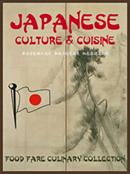|
Contents:
Home/Intro
History of Japan
Japanese Culture
Japanese Food
History
Common Dishes
Sushi
Japanese Rice
Eating with
Chopsticks
Table Settings &
Etiquette
Tea in Japan
Sake
Japanese Snacks
Japanese RECIPES
Cooking & Food Terms
Useful Words & Phrases
Food Matters
Resources & Credits
More:
Food Fare
About Food
Fare
Contact
Food Fare
Cookbooks
Culinary
Collection

E-book edition of "Japanese Culture & Cuisine" > |
Rice
There are many variations of rice in Japan, although most are of the
short-grained variety. The importance of rice in the Japanese culture is
confirmed in the language:
-
Breakfast means "morning rice" (asa-gohan).
-
Lunch means "noon rice" (hiru-gohan).
-
Supper means "evening rice" (yuu-gohan).
Rice is grown in most areas of Japan apart from mountainous regions,
with most cultivation now undertaken by machinery.
Rice is the featured ingredient in many Japanese dishes. A few of
the most commonly prepared include:
-
Chachan:
Stir-fried rice with carrots, egg, peas and pieces of pork.
-
Donburi: Consists of a bowl of
rice topped with other foods such as
Tempura (tendon), egg and
chicken (oyakodon),
tonkatsu (hatsudon),
beef (gyudon) or eel (unadon).
-
Fried Rice:
Chachan has several other ingredients as well,
including pieces of scrambled egg, peas, green onion, corn, leek
and diced ham.
-
Gomokumeshi: Rice
boiled with fish or chicken and a variety of vegetables such as
carrots, lotus root, mushrooms and peas.
-
Hatsuga genmai:
Germinated brown rice with a soft texture.
-
Kurigohan: Steamed rice with kuri
chestnuts.
-
Mochi: Rice cakes.
-
Okaiyu: Soft-cooked
rice gruel, similar to oatmeal.
-
Omochi: Stickier than
normal; pressed into rice cakes.
-
Omuraisu:
Cooked rice wrapped in a thin omelet; typically served with
gravy or ketchup.
-
Onigiri: Rice formed into small balls and
wrapped with seaweed (nori). Pickled vegetables or meat
can be placed into the center of the balls.
-
Osenbei: Rice-cake snacks
similar to salty crackers.
-
Sushi Rice: Prepared with vinegar
and used for various sushi rolls.
-
White Rice: Japanese cooked
white rice should be sticky so eating with chopsticks is easy.
Bowls of rice are served with most meals.
Japanese rice (also known as japonica) is unique because of
its "stickiness" and texture. The glutinous quality is conducive to
the variety of dishes native to Japan.

•
Next: Eating with Chopsticks >
|

